Types of Florida Bugs and Insects (With Pictures) – Identification Guide

Florida is home to many species of bugs and insects. The year-long warm, humid climate in the Sunshine State means that insects like roaches, fleas, ticks, ants, weevils, and wasps can thrive throughout the year. In addition, bugs and insects in Florida can often find their way into homes, causing a nuisance for homeowners.
Knowing how to identify common insects and bugs in Florida is vital for residents and visitors to the southeastern United States. Some insects in Florida, like the black widow spider, mosquitos, bed bugs, wasps, and chiggers, can cause a nasty bite or sting and spread disease. Other flying insects like termites and flies can become a pesky annoyance.
This article is an identification guide for the most commonly seen Florida bugs and insects. Descriptions and pictures of common Florida bugs will help you recognize these creepy crawlies in your home, yard, or parks.
Florida Bugs vs. Insects
Most people refer to all pesky insects in Florida as bugs. However, true bugs are insects that belong to the order Hemiptera. These small creatures have straw-like mouthparts they use to suck juices from plants. On the other hand, the classification “insect” is more wide-ranging and includes all small creatures with three body parts and six legs.
Therefore, all bugs are insects, but not all insects are classified as true bugs. It also gets confusing because some insects that are not true bugs, like red bugs (chiggers) or pillbugs, have “bug” in the common name. However, because people commonly refer to all small annoying insects as bugs, we will use the terms interchangeably in this article.
Types of Florida Bugs
There are several types of insects in Florida that are in the order Hemiptera. Let’s look in detail at a few of these annoying creepy crawlies.
Bed Bugs (Cimex spp.)

The tiny brown bed bugs have a flat body and can quickly infest houses in Florida
Bed bugs are some of the more common bugs in Florida. The nuisance house pests are tiny brown, pear-shaped insects measuring 0.2” to 0.27” (5 – 7 mm) long. These pests lurk in dark corners and crevices, behind baseboards, mattress seams, and box springs, making them difficult to find.
Other signs of bed bugs include red, itchy marks and welts on the skin. In addition, bed bug bites cause localized swelling and blisters. You might also notice brown blood marks on bed linen. This is because they use their piercing mouthparts to puncture the skin and suck blood.
Florida Bug Identification: Bed bugs are tiny reddish-brown insects about the size of an apple seed. They tend to congregate in groups, making them easier to spot.
Stink Bugs (Pentatomidae)
Stink bugs are gray, reddish-brown, or black insects with distinctive shield-shaped bodies covered in mottled patterns. As their name suggests, these bugs emit a foul stench when crushed. The six-legged bugs with their sucking mouthparts measure 0.67” (17 mm) long and wide. Stink bugs in Florida usually have identifiable red or orange marks on their bodies.
Types of stink bugs common in Florida are the following:
- Florida predatory stink bug (Euthyrhynchus floridanus): Dark blue or black color with three red or orange spots on its back.
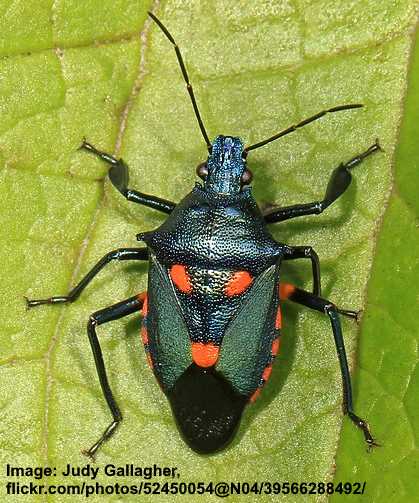
Florida predatory stink bug (Euthyrhynchus floridanus)
- Southern green stink bug (Nezara viridula): A bright green bug with a characteristic shield shape. It’s a pest outdoors, feeding on soybean and cotton plants.
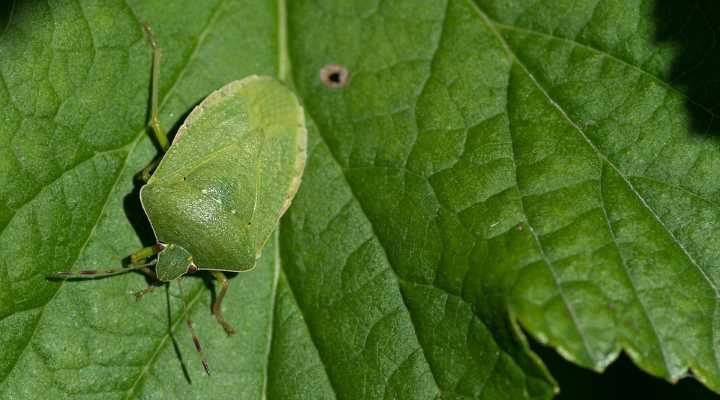
Southern green stink bug (Nezara viridula)
- Brown marmorated stink bug (Halyomorpha halys):An invasive bug that sometimes gets into homes in North Florida during winter. It has a mottled grayish-brown body, measuring 0.59” (15 mm).
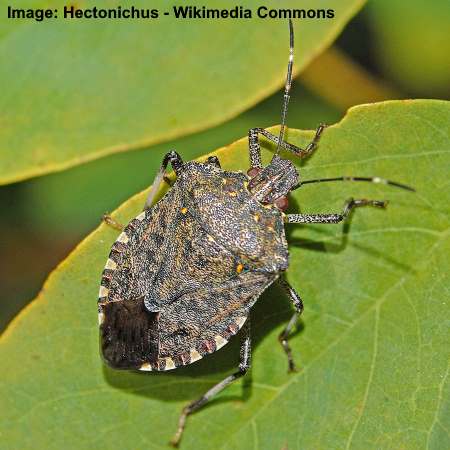
Brown marmorated stink bug (Halyomorpha halys)
Pillbugs (Armadillidium vulgare)
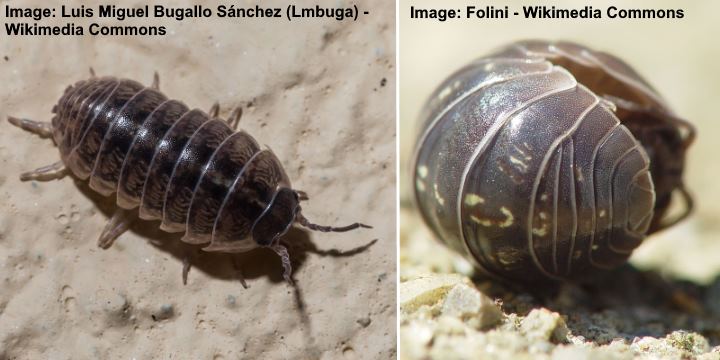
Pillbugs have dark hard segmented shell and can roll when they feel threatened and are common in Florida
Pillbugs are a group of small, pesky insects commonly found in homes in Florida. The wingless, oval arthropods look like tiny dark gray or black armadillos. The insect-like creatures measure 0.33” to 0.70” (8.5 – 18 mm). The small dark-loving creatures do not bite or sting and are completely harmless.
Also called woodlice, roly-polies, or sow bugs, these grayish creatures are neither insects nor true bugs. Instead, they are isopods related to crabs and other crustaceans. They have a habit of rolling into a ball when threatened.
Florida Bug Identification: Pillbugs have a barrel-shaped dark gray to black shell, seven pairs of legs, and a seven segmented body protected by an armadillo-like shell.
Types of Florida Insects
Insects are common throughout the southeastern United States, with many insects native to Florida. Read on to find out identification information on the Sunshine State’s most common insects.
Palmetto Bug (Eurycotis floridana)
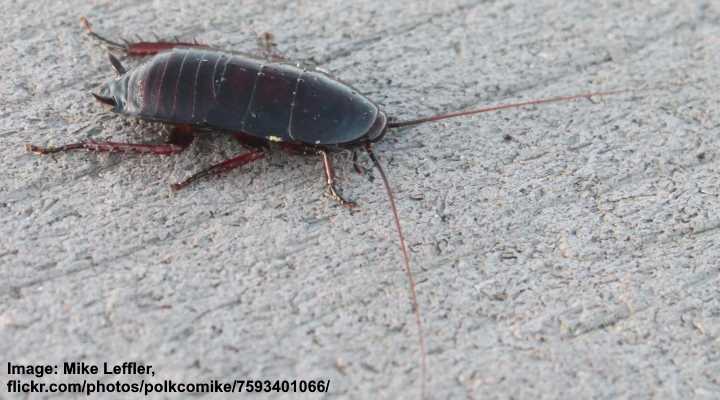
The palmetto bug is identified by its flattened dark brown body and can be found in humid warm climates such as in Florida
Also called the Florida woods cockroach, the palmetto bug is a dark brown to blackish-brown insect. The native Florida “bug” measures 1.2” to 1.6” (30 – 40 mm) long. It has an oval, flattened body and two slender antennae. You will find the insects in humid, warm climates, commonly in homes in subtropical climates.
The large roach also goes by the names Florida skunk roach, stinkroach, and Florida cockroach. This refers to its habit of emitting a foul-smelling liquid to defend itself. It also looks like the American cockroach—another common Florida insect.
Florida Insect Identification: The palmetto bug has a reddish-brown, flattened body, six spiny legs, two long antennae, and two protruding tail-like structures.
Red Fire Ant (Solenopsis invicta)
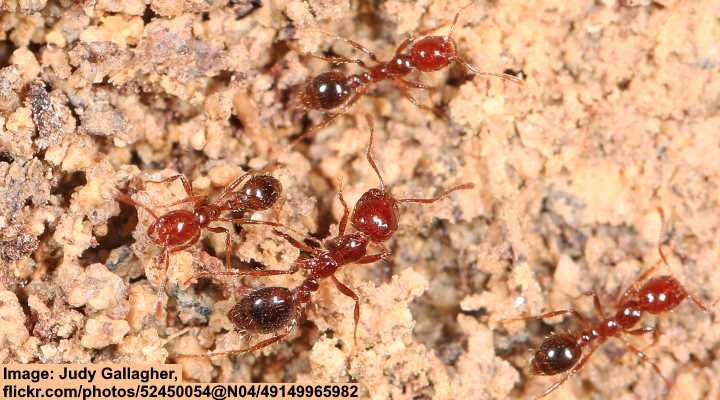
The small red fire ant is commonly found throughout Florida and has a painful bite
The red fire ant is one of the worst biting insects in Florida. Of course, ants are common throughout the state, but this tiny red insect can inflict a painful bite—like being stung by a red-hot poker. The small, slender red ants measure 0.09” to 0.23” (2.4 – 6 mm). They have a characteristic bulbous abdomen and head with a thin waist.
Described as a serious stinging pest, the red imported fire ant is commonly found throughout Florida. Due to the tropical climate, these stinging ants can be active throughout the year. In addition, large colonies of ants can be a significant nuisance, as nests under buildings can cause structural problems.
Florida Insect Identification: The red fire ant is a small, slender, stinging insect with a relatively large head and abdomen. These non-native ants are red to reddish-brown in color.
Florida Carpenter Ants (Camponotus floridanus and Camponotus tortuganus)
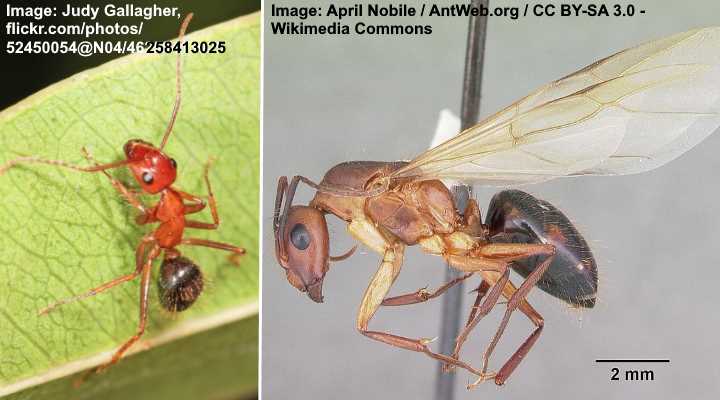
Two of the most common carpenter ants in Florida are Camponotus floridanus (left) and Camponotus tortuganus (right)
Two common species of carpenter ants are found in Florida. These red and black ants range in size from 0.21” to 0.43” (5.5 – 11 mm) long. The ants are identified by their elbowed antennae, tear-shaped abdomen, large forewings, and thin waist. The ants can bite but are usually more of a nuisance as they look for food indoors.
Carpenter ants are some of the most common indoor pests in Florida. The foraging ants emerge in the evenings and swarm between April and June. The annoying ants feed on sweet and sugary substances and are common in kitchens and bathrooms.
Carpenter ants are often mistaken for flying termites in Florida. However, the ants, unlike termites, don’t cause any structural problems in wooden structures or buildings.
Florida Insect Identification: Carpenter ants have an oval to pear-shaped abdomen, a thin waist, and two antennae that bend at right angles. These red and black ants are common in Central and South Florida.
Mosquitoes (Culicidae)

Mosquitoes are bloodsucking flying insects, and Florida is a home for many species of them
Florida is home to more than 80 species of mosquitoes. These notorious biting insects pierce the skin to feed on blood from humans and animals. The tiny flying insects are identified by a pair of wings, a long biting organ (proboscis), and dangling legs in flight. Mosquitoes are dark gray to black and measure 0.23” to 0.51” (6 – 13 mm) long.
Mosquitoes tend to congregate near standing water and ponds and are active throughout the year in the Sunshine State. However, they can be nuisance pests in the home as they buzz around dark rooms sucking blood from unsuspecting people. In addition, some species of Florida mosquitoes carry diseases, including the West Nile virus, dengue fever, and Zika viruses.
Florida Insect Identification: A mosquito is identified as a slender, long-legged insect with a protruding biting organ it uses to have a blood meal.
Related reading: Plants that repel mosquitoes.
Fleas (Siphonaptera)
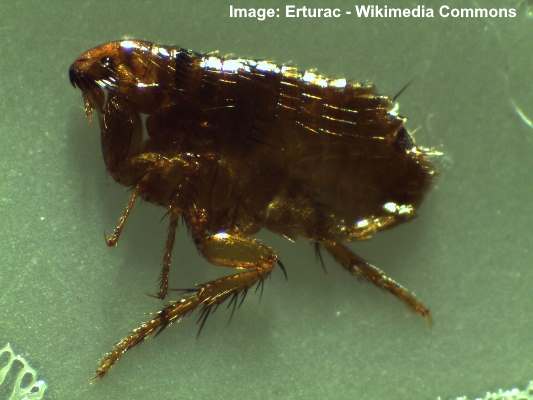
A close up picture of a flea (35x zoom optical microscope)
Fleas are a common house bug in Florida that get into homes on the back of pet cats and dogs. These tiny reddish-brown blood-sucking insects have an oval body, long spiny legs, and mouthparts they use to pierce the skin of their hosts. The tiny jumping insects measure around 0.12” (3 mm) long.
Signs of fleas are usually due to the itching their bites cause. Flea bites are small, itchy red bumps that usually appear in groups of three or four bites. Your pets may have fleas if you notice them scratching excessively. Sometimes, you notice the small grain-like insects on white bed linen before they jump away.
Florida Insect Identification: Fleas are tiny insects with a reddish-brown oval, flattened body and six legs. They are so tiny you may need a magnifying lens to see their features up close.
Ticks (Ixodida)
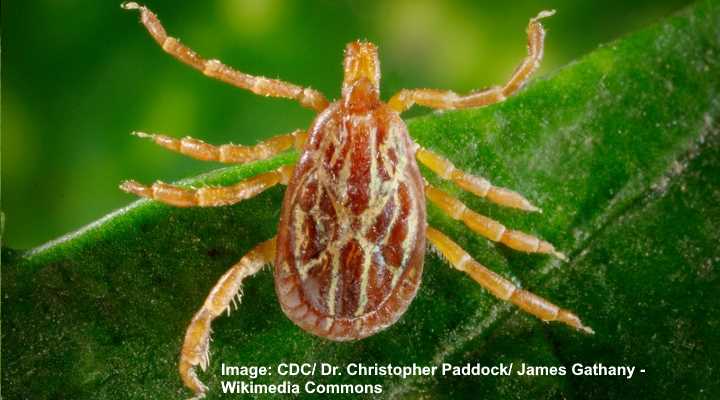
The Gulf Coast tick (Amblyomma maculatum) is the most common tick in Florida
Ticks are tiny brown or black bugs about the size of a sunflower seed. The minuscule insects measure 0.2” (5 mm) long. The problem ticks cause is when they bury into the skin to take a blood meal. These engorged insects can swell to three times their size after feeding on blood.
According to the Florida Department of Health, ticks can spread several diseases in the state. These include Lyme disease, Rocky Mountain spotted fever, and Ehrlichiosis. The Gulf Coast tick (Amblyomma maculatum) is the most common tick in Florida.
Therefore, if you notice a tick buried in your skin or have a red target-like swelling, you should seek prompt medical advice.
Florida Insect Identification: Identification features of ticks are their tear-shaped black or brown bodies and eight legs (ticks are not insects; instead, they are mites).
Chiggers (Trombiculidae)
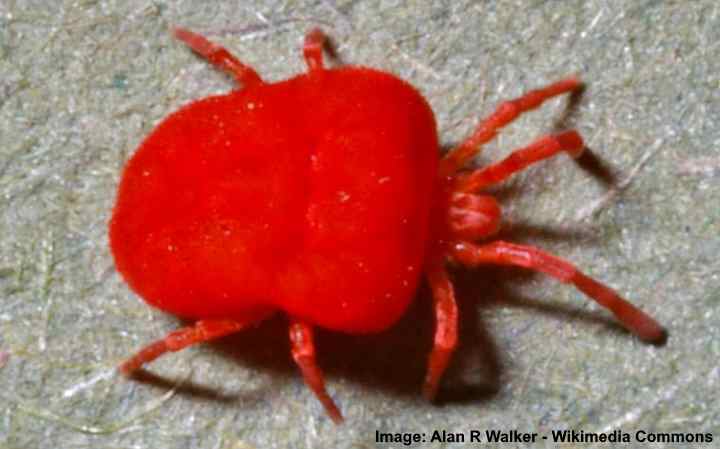
A close up image of a chigger (Trombicula autumnalis)
Like ticks, chiggers are a type of parasitic mite with eight legs and biting tendencies. However, the tiny red bugs have a bright red, oval body and don’t grow more than 0.01” (0.4 mm) long. These nasty little bugs cause intensely itchy welts that can take two weeks to heal.
Florida Insect Identification: Identification features of chiggers are typically their itchy red bites as they are almost invisible without looking through a magnifying glass. However, they have orange-red to reddish-brown oval bodies.
Deer Flies /Yellow Flies (Chrysops)
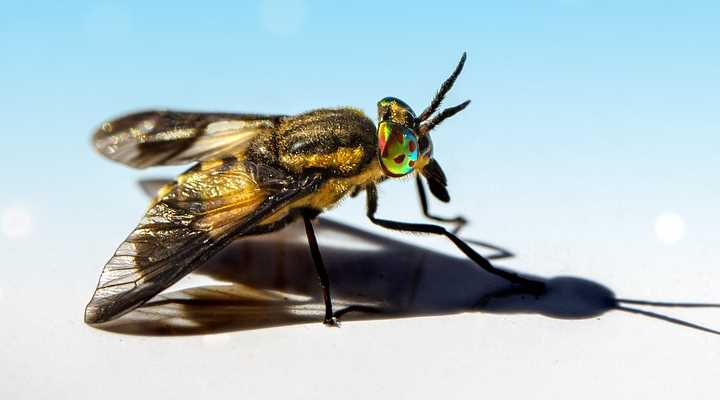
The yellow and black deer flies are blood sucking insects that are found around wet areas in Florida
Deer flies can be major pests when spending time outdoors in Florida. The blood-sucking flies are common around swimming pools and ponds and prefer sunny spots. The small yellowish flies measure 0.27” to 0.39” (7 – 10 mm). The yellow and black striped flies have black bands across their wings.
Florida Insect Identification: Deer flies are identified by their black and yellow abdomen and wings with dark patches. They look similar to yellow flies and are slightly smaller than horseflies.
Termites (Isoptera)

Termites can infest Florida homes and cause extensive damage to wood
Florida is one of the worst states in the US for termite activity, with Tampa, Orlando, and Miami reporting the highest number of termites. Termites are small white bugs with bulbous heads, wings, and six legs. The flying ant-like insects feed on cellulose fibers in wooden structures. The destructive pests measure 0.15” to 0.6” (4 to 15 mm) long.
Termites thrive in warm, humid environments like the Florida climate. Species of termites common to the Sunshine State include the following:
- Subterranean termites
- Formosan termites
- Dampwood termites
- Dampwood termites
Depending on the species, termites can swarm in Florida during most times of the year.
Florida Insect Identification: Identification features of termites include a thick waist, a creamy-white color with often a brown head, two clubbed antennae, and a pair of wings the same size.
Fruit Flies (Drosophila)

Fruit flies are tiny brown house pests in Florida that especially like sweet rotten fruit
Fruit flies are annoying pests in Florida homes throughout the year. Native Florida fruit flies are yellowish-brown and have red eyes and a black rings in their abdomens. They measure 0.1” (2.5 mm) long and commonly hover around rotten fruit, garbage cans, and decaying meat.
The best way to get rid of these tiny flying insects is to remove their food source.
Florida Insect Identification: Fruit flies look like tiny gnats that hover near fermenting fruit or sugary substances.
Spiders
Florida has several species of native spiders, some of which can give a nasty bite. The way to identify species of Florida spiders is to note their size, specific markings, and whether they have hairy bodies. Here are a few examples of how to identify common Florida spiders:
- Brown recluse spider (Loxosceles reclusa): It has a dark violin pattern on its back and measures 0.25” to 0.5” (6 – 12 mm) long.
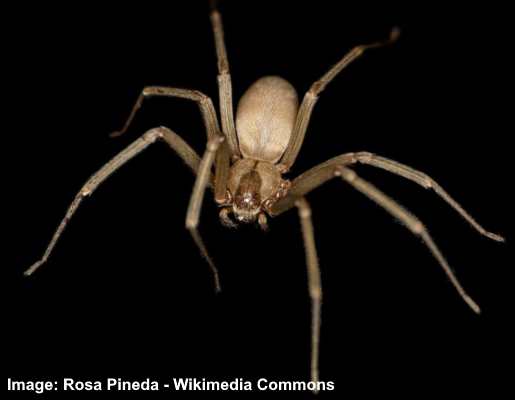
Brown recluse spider (Loxosceles reclusa)
- Brown widow spider (Latrodectus geometricus): Look for the characteristic hourglass red mark on its brown-colored abdomen. It measures 0.47” – 0.6” (12 – 16 mm) long.
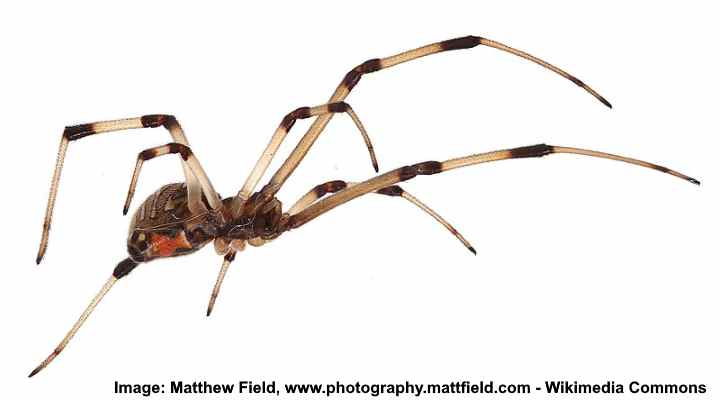
Brown widow spider (Latrodectus geometricus)
- Domestic house spider (Tegenaria domestica): This brown spider has dark patterns on its abdomen and two black stripes on the front part of its body. It measures 0.24” to 0.47” (6 – 12 mm) long.
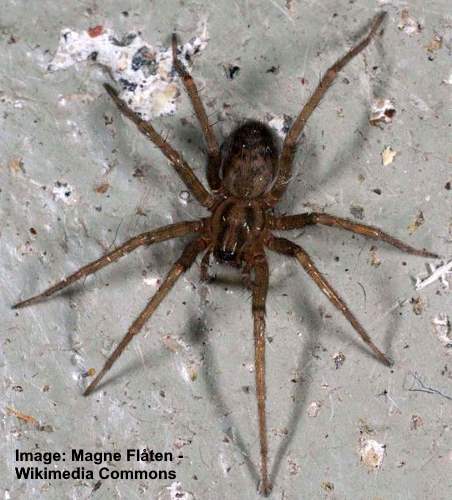
Domestic house spider (Tegenaria domestica)
- Common house spider (Parasteatoda tepidariorum): The tiny spiders are common throughout the state and have a tan color with mottled patterns. They measure up to 0.24” (6 mm) long.
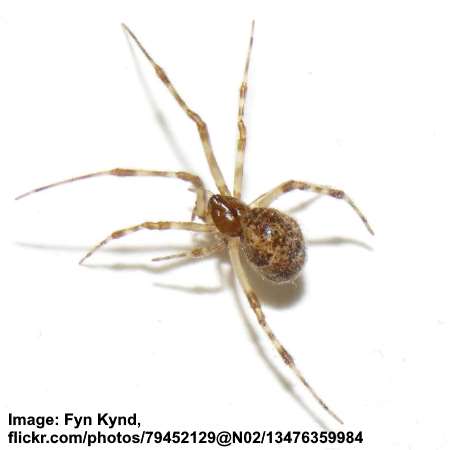
Common house spider (Parasteatoda tepidariorum)
Eastern Bark Centipede (Hemiscolopendra marginata)

The eastern bark centipede is native to South Florida and is identified by a long bluish body with numerous creamy legs
Also called the Florida blue centipede, this large multi-legged, worm-like insect is native to southern Florida. The wriggling creature has a bluish body with cream-colored legs running down either side. As with all centipedes, they are carnivorous insects that hunt and prey on other invertebrates like earthworms, snails, slugs, insects, and spiders.
The fascinating centipedes grow up to 4” (100 mm) long.
Florida Insect Identification: The native Florida centipede has a distinctive bluish body with pairs of light-colored legs along its sides.
Flies
Small flies are common pests in many homes in Florida. The small annoying flying insects have a pair of wings, six legs, and large compound eyes. Types of flies common in Florida include the following:
- Common housefly (Musca domestica): Its identifying features are its black and gray striped body, reddish-brown eyes, and transparent wings.

Common housefly (Musca domestica)
- Drain flies (Psychodidae): These fuzzy gray-brown flies typically live in the sludge in drains. They measure 0.078” to 0.19” (2 to 6 mm) long.
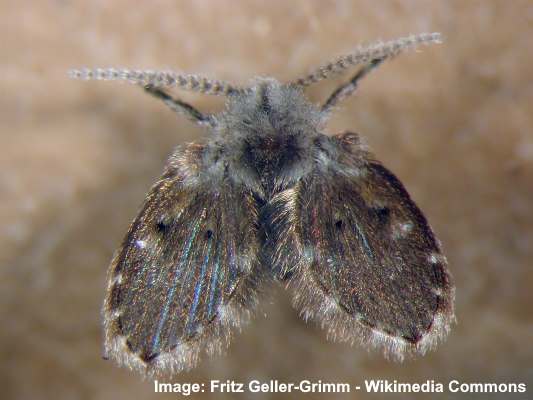
Drain fly (Psychodidae)
- Fungus gnats: Measuring 0.079” to 0.30” (2 – 8 mm) long, these small black house flies live in houseplant soil and are often mistaken for fruit flies.
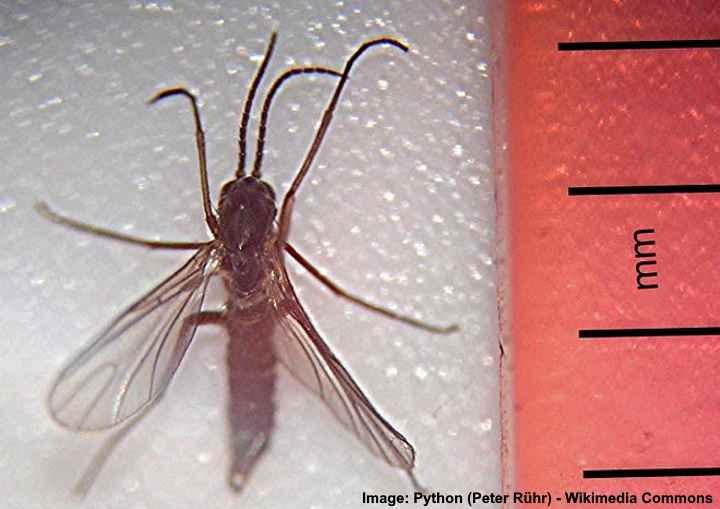
Fungus Gnat
Silverfish (Lepisma saccharinum)

Silverfish is a creepy gray bug commonly found in damp places in Florida homes
Silverfish are identified by their tear-shaped gray bodies, long antennae, and metallic scales. These grayish bugs are often found in damp, dark places. They have a characteristic habit of slithering across floors with fish-like movements. Silverfish are not dangerous and don’t bite. They measure 0.33” (8.5 mm) long.
Florida Insect Identification: Silverfish are easy to identify due to their tapered body with a silvery sheen, wriggling movements, and a pair of long antennae.
Pantry Weevils
Pantry weevils are tiny black or dark brown bugs in Florida that can infest kitchens and stored dried foodstuffs. Pantry weevils are tiny beetles with distinctive snouts, oval bodies, six legs, and two clubbed antennae. These annoying pests contaminate grains, cereals, dried beans, nuts, and rice. Types of pantry weevils include the following:
- Maize weevils
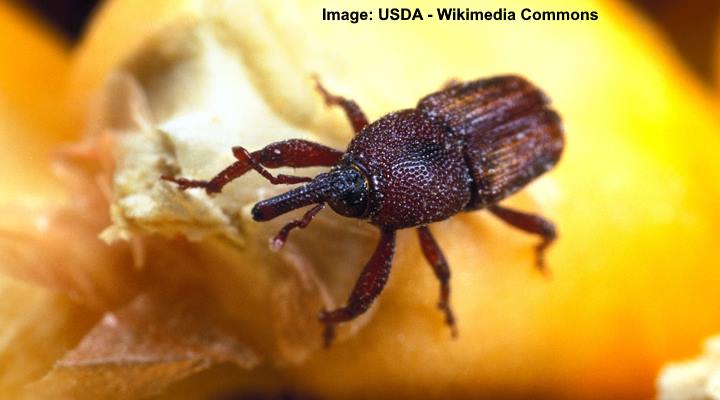
Maize weevil (Sitophilus zeamais)
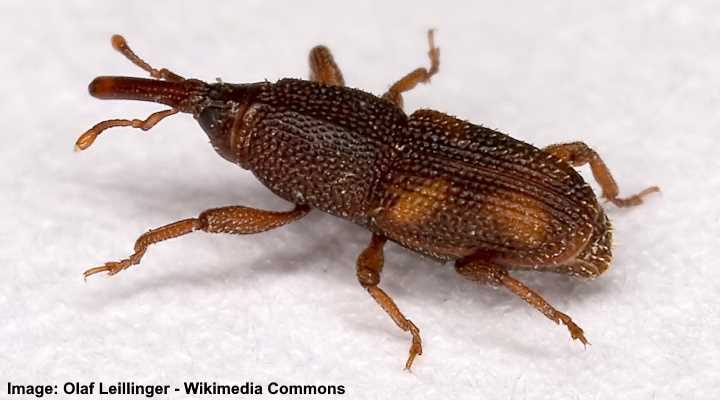
Rice Weevil (Sitophilus oryzae)
- Granary weevils
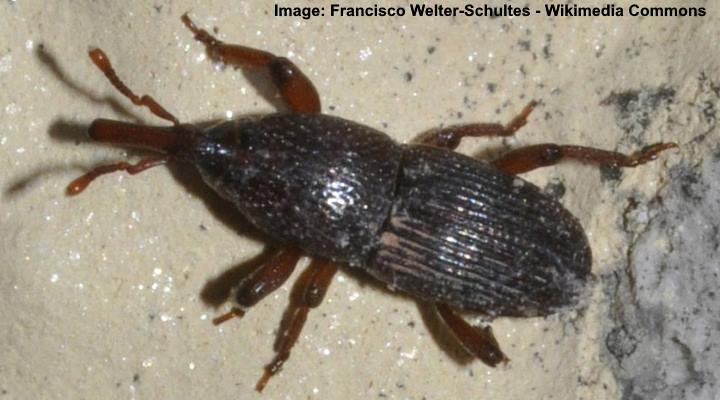
Granary weevils (Sitophilus granarius)
Florida Insect Identification: To identify pantry bugs, look at their body shape, color, and distinctive patterns. Many types of weevils have ridged markings on their backs.
Cicada Killer Wasp (Sphecius speciosus)
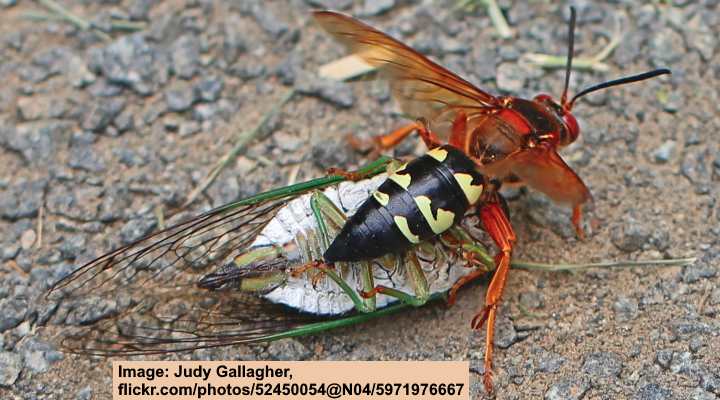
A picture of cicada killer wasp (Sphecius speciosus) with a cicada
The eastern cicada killer wasp is a large black wasp with broken yellow bands on its abdomen. This huge wasp’s other identifying features are its rusty-orange legs and wings, black patch on its thorax, and black antennae. These large colorful wasps are some of the largest stinging insects in Florida.
Black and yellow cicada killer wasps grow to 2” (5 cm) long. As the name suggests, the wasps feed on cicadas in the Sunshine State.
Florida Insect Identification: They measure 0.5” to 0.75” (13 – 19 mm) long.
Yellowjackets (Vespula or Dolichovespula)
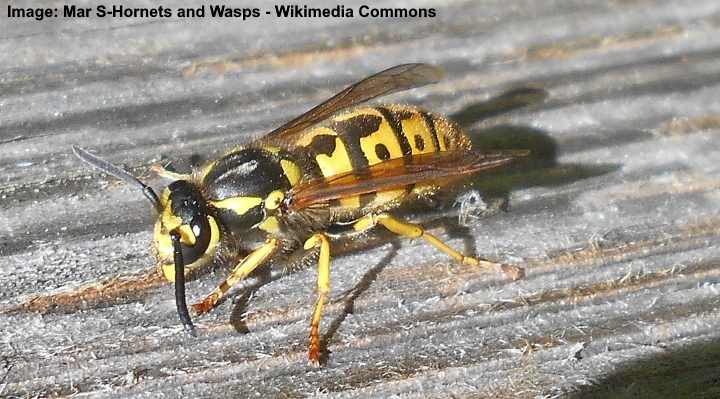
A close up picture of Vespula germanica (European wasp, German wasp, or German yellowjacket)
Yellowjackets are the most common type of wasp in Florida. These black and yellow striped wasps are easy to confuse for hornets and paper wasps—also relatively common Florida flying insects. Additionally, yellowjacket wasps have lance-like stingers and can give you a nasty sting. Yellowjackets measure 0.5” (1.2 cm) long.
Florida Insect Identification: Yellowjackets are identified by their yellow and black stripes, pointed abdomens, and large C-shaped compound eyes.
Related articles:
